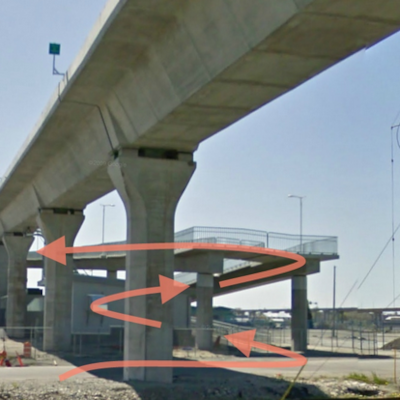
Summary
We have developed a simulation model that predicts travel time and energy costs for a bicyclist traveling over an arbitrary route accounting for elevation changes, bicycle type, rider physiology, traffic signals, and yielding.
| Theme | Bicycle Engineering | Current Researchers | |
| Last Worked On | October 2024 | Past Researchers | Sietse Soethout |
| Collaborators | Ted Beuhler, Mont Hubbard |

Direct and squiggly routes have time and energy costs for bicyclists.
Description
Bicyclists choose routes at least partially based on the travel time and the energy required to traverse the route [Winters2010]. Grade changes, wind, stop signs, traffic signal timing, rough pavement, undulations, etc. all contribute to the time and energy costs [Broach2012]. Urban planners and civil engineers design infrastructure and routes for bicyclists that have specific time and energy costs associated with them. In fact, automobile routes and infrastructure often have more preferable time and energy costs than the parallel bicycle routes and infrastructure. These bicycle routes are quite squiggly and are not optimizing the convenience of the bicyclists over the automobile drive. Using simple physics-based simulations, existing and future routes and infrastructure designs can be evaluated for time and energy costs. This puts a clear quantitative numbers to important aspects of the convenience of bicycling.
Products
Theses
- S. S. Soethout, "A dynamic utility cycling model for energy and time expenditure calculation of a population of cyclists," Delft University of Technology, Delft, The Netherlands, 2024. https://resolver.tudelft.nl/uuid:ae45c43e-8eb1-4256-b7c2-e290f1260def
Presentations
Software
- Software from the 2012 work: https://github.com/moorepants/EfficientRoutes
Media
The following video shows a single simulation along a route in The Hague, The Netherlands:
The next video shows a population of cyclists riding the route:
References
| [Winters2010] | M. Winters, K. Teschke, M. Grant, E. M. Setton, and M. Brauer, "How Far Out of the Way Will We Travel?: Built Environment Influences on Route Selection for Bicycle and Car Travel," Transportation Research Record: Journal of the Transportation Research Board, vol. 2190, no. 1, pp. 1–10, Jan. 2010, doi: 10.3141/2190-01. |
| [Broach2012] | J. Broach, J. Dill, and J. Gliebe, "Where do cyclists ride? A route choice model developed with revealed preference GPS data," Transportation Research Part A: Policy and Practice, vol. 46, no. 10, pp. 1730–1740, Dec. 2012, doi: 10.1016/j.tra.2012.07.005. |

